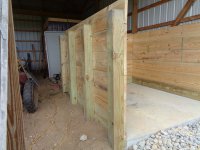Do you have your heart set on concrete? If all you want is a fairly smooth stable floor, you could do what my FIL did.
He had a 20' x 30' steel building on a fairly remote section of the farm. It was accessible only by tractor and used to store implements. It had a level stone floor but he wanted something smoother. Costs estimates to do concrete were very high due to the location, so he used this product instead.
View attachment 1884256
These heavy duty grid pavers are the ideal subsitute for cement pavers. Ideal for adding weight bearing capacity to driveways and parking areas.

www.agtec.com
He brought in sand with the FEL, used it to choke off the stone and raked it level. He then brought in the pavers, laid them out and filled them with stone dust. He soaked the surface with water and it dried hard and fairly smooth.
That was 5 years ago and the surface has held up well under heavy equipment. It cost significantly less than concrete and he was able to do the job himself in 4 days.
I like the look of it but wouldn't consider it for a finished garage. For an out building though, IMO, it's an acceptable alternative to concrete.



